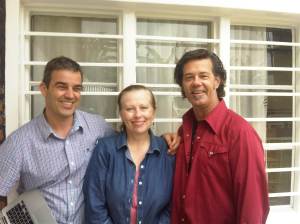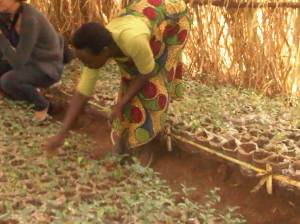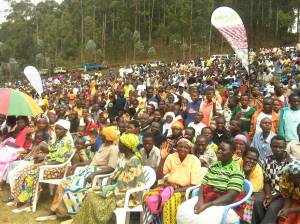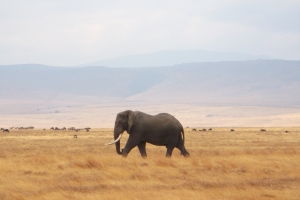Our Blog

TED’S ADVENTURES IN AFRICA
Our head roaster Ted Vautrinot represented Kean Coffee in Rwanda this summer as a judge for the Rwanda Cup of Excellence competition. Below is a preview of his travel blog, which will be published in it’s entirety very soon.
I stepped off the plane onto the rolling aluminum stairway straight out of 1969 and was enveloped by the close, wet heat of Central Africa. It was 7pm and it still felt like we’d walked into a hot, damp, wool blanket. I was grateful for the conversation of my friends and fellow cuppers Thomas and Anika as we waited in the interminable line to get our passports stamped with “Kigali, Rwanda”. This was my first trip to Africa, and I was excited and apprehensive about the possibilities of finding great coffees and a new adventure in a strange land. I’ve participated in Cup of Excellence (COE) competitions before, and I’d worked with the Head Judge Sherri Johns before, I knew the cupping would be professional and organized. This was a new continent, though- a new people, a new language… In some ways I would be starting from scratch to find my African origin experience.
We climbed into a van the next morning to travel from Kigali to Rwamagana under leaden skies to join the rest of the cuppers and staff that were assembled at the lab there. Rwanda’s geography and the season kept the countryside perpetually shrouded in a light mist for most of our stay. As we drove the two hours to the lab I was struck by two things: First, the country was completely clean- there wasn’t a speck of the litter in the markets or on the roadside that is common throughout Central America. Second, most every man, woman, or child walking along the roadside were carrying a yellow five-gallon plastic jerry can to transport water from a clean source to their home- sometimes as far as 3 miles in one direction. Despite the hardship conditions they live under, Rwandans take an immense pride in their land, their country.
I was pleased to find that Sherri had, true to form, prepared the lab and the staff impeccably. Sherri and Martin Diedrich have a long professional history- Sherri helped Martin create the menu and recipes we’ve used at Kean Coffee since the beginning. Sherri and the 20 Rwanda National cuppers had slogged through the hundreds of submitted samples and passed the top 60 to us, the International Jury. We would spend the next 5 days calibrating and then winnowing the field down to the top 10 coffee Rwanda has to offer for this year. We would have to be consistent and exacting on every round to give each coffee its fair shot. For every round of 10 coffees, four examples of each coffee are precisely weighed and ground and placed on each table. The judges score on fragrance, taste, acidity, body, complexity, finish, and uniformity. The presence of mind to keep track of all the subtle differences of 40 cups of coffee as they are changing and cooling is daunting and takes practice. Alongside our 20 International Judges were 8 observers who were learning and honing their judging skills. We cupped and compared scores against each other and the National Jury, who had stayed on to support our efforts by preparing, roasting, and cataloguing our rounds. Sherri and I also got to introduce the Rwandan cuppers to coffees of the world. I had brought Kean Coffee production roasts of Guatemala, Ethiopia, Sumatra, and Hawaii coffees with me and we set up a cupping for the national jury. None of these Rwanda experts had ever tasted a coffee from outside their own country; it was all a brand new experience. Not surprisingly, the cuppers had an easier time with the African coffee. It was great fun to watch their eyes grow wide and question marks fill their expressions as they tasted the Guatemala and Sumatra coffees- so very different from what they’d ever tasted before- and then tell them these were 90 plus examples of those region’s coffees. 
By the end of the day our taste buds were ndarushye (tired), and we climbed aboard the bus for the short trip to the local hotel. We were being treated very well indeed, for our hotel had electricity more than half the time, and often had hot water in the rooms. In the soft night air we caught up and traded coffee and travel stories over dinner in the bar while the Kenyan soap opera (in English, no less) played out on the TV in the background. We had come from Japan, Korea, Germany, Russia, Great Britain, Australia, Finland, and the US to share our love of truly exceptional coffee here in the heart of Africa.
The next three days we worked in earnest as we scored the coffees to decide which would move to the final rounds. The power had been intermittent at the lab, and the backup generator failed, so the staff had lost some roasts and were running behind. Over the week they consistently worked 14-18 hour days keeping the samples in order for us to evaluate them fairly. The three Rwanda flavor profiles became clear; a rich, jammy, creamy profile; a soft tea-rose aromatic profile; and a spicy cedar, hazelnut profile. Rwanda coffee has come a long way in the last 20 years as more and more care is given to the cultivation and harvesting of the country’s second biggest export crop (after bananas). We kept our noses to the grindstone and narrowed the field to the ten coffees we would rate as the best this year. Taking our “ibiryo” or meals with the staff we got to learn a little of the language and about their lives over rice, potatoes, beans, baked bananas, yucca, and every other starch imaginable along with a hint of greens and a sliver of protein. On one afternoon we got to visit some producing farms on the shore of Lake Kivu. The next afternoon we were allowed a special visit to the genocide memorial in Kigali, a moving and sobering reminder of the events that have shaped this culture.
Our final round was the ten finest coffees from the first three days of cupping, and we tucked into them with focus and gusto. Each were coffees I’d be proud to bring back to my family and friends. Comparing notes afterwards I was also pleased to see that my scoring was well-calibrated with the national cuppers. I had learned more in this week about the details of Rwanda coffee than in the previous two years in our lab, from the sheer volume of coffees and the expert help. We celebrated over dinner that night with our National staff, and the Governor of the Eastern Province showed her support by joining us. Afterwards we shared the Rwanda love of dance as the DJ played African Hip-Hop and Dance tunes and the umuhungu and umukobwa (boys and girls) slipped easily in and out of groups. No couples, just groups of dancers joining and splitting- migrating across the floor as the beats seeped through us and gently pushed us around.
Next morning we headed back through Kigali and then north to Byumba for the Awards ceremony. We had seen a few commercials on national TV about COE, and even saw billboards in Kigali, but we weren’t prepared for the throngs of people who had walked miles into the countryside to the site of the awards. The huge grassy field was ringed on all sides with thousands of local farmers and their families, visiting dignitaries, and government officials while a traditional dance troupe performed and sang. Each dignitary was compelled to give a speech, but the only Kinyarwanda I understood from them was the occasional “Ikawa nziza” or excellent coffee. A poet performed her piece about the life of a coffee plant using the analogy of a woman growing up and maturing, and though I barely understood a word of the Kinyarwanda I could connect with the passion and humor in her soul about this plant and what it means to these people. As the awards were presented the crowd’s applause grew with each winner, culminating with the first place award while the Governor and dignitaries jostled each other to make sure they each got into the winner’s photos. I was filled with joy and pride to see so many people taking the quality of their land and their work so much to heart. After the ceremony we exchanged our murakoze’s (thank you) and murabeho’s (goodbye) with our new friends and headed on uragende amahoro (peaceful journey) back to Kigali.
Next found me on a flight from Kigali to Moshi, Tanzania at the base of Mount Kilimanjaro. Because of Martin’s long relationships with producers and exporters around the world I was hosted by Sustainable Harvest and their satellite office in Tanzania. Boss Farijallah picked me up at the crisply modern airport (every tourist that visits Kilimanjaro passes through Moshi) and got me settled into town. Boss is an agronomist and engineer, and a fine cupper. Over a curry dinner we swapped stories and Boss filled me in on Sustainable Harvest’s work in Tanzania. Kean Coffee has bought coffee through the Portland, Oregon-based company before, so I was keen to see their operations on the ground. Sustainable’s mission is to provide low and high technology to the coffee farmers so they can produce higher quality for better prices. They also help develop secondary crops, like mushrooms, for the families’ consumption and for sale at market. The concept is to make coffee farming viable and profitable for the farmer so they can continue to produce generation after generation and provide a good life for their families.
Next morning Boss picked me up and we headed to Kilicafe’s offices in Moshi. Kilicafe supports and markets different cooperatives throughout Tanzania and works with Sustainable Harvest bringing green coffee to the international market. We met Lazaro Haonga there and talked about the challenges they face- shrinking yields as some trees approach 80 years of production, water conservation, declining interest in coffee by the next generation. Then we got to the nitty gritty and cupped a round of coffees in Kilicafe’s lab. Of the eight coffees we cupped at Kilicafe and the subsequent six later at Sustainable’s lab the three of us were never more than a point apart. This will be valuable as we continue to ask these groups to send us samples of 86 points and above, as we are clearly calibrated and agree and the ratings of different grades of coffee. Kean Coffee can focus on the high-quality samples we’re looking for and they can save their money and resources by offering their lower grade coffee to other buyers. Later that afternoon I got to meet with Sustainable’s Director in Tanzania, Rocio Diaz-Agero, and Boss and hear the details on the programs they’re implementing on the ground, like rainwater harvesting, natural compost and fertilizers, and battery-operated mobile cupping kits.
Next morning seven of us squeezed into the Land rover and headed out to visit some producers. The first cooperative was Sing’isi, about 60 kilometers west of Moshi. Like most Tanzania cooperatives, Sing’isi is a collective of about 500 holder/farmers some might have a few dozen trees, others a hundred. During the harvest they all bring their ripe cherry to the washing station where it’s pulped and then dried on raised beds. Sustainable has been helping them with water conservation and mushroom farming. They continue to work on raising quality with healthy new stock and better harvesting techniques. In a few years they might raise their coffee to the level that Kean buys. I explained our operation and the kind of coffees we deal with, and the level of quality our customers are accustomed to. We shared ladha (tasty) boxed lunches, and afterward shared music on a guitar I’d brought with me, trading songs and licks with a local farmer who also played. At the end of our jam I donated the guitar to the cooperative on behalf of Kean and Sustainable Harvest. The Mill manager, cooperative President, and guitar player/farmer were all grateful and touched, saying “Asante sana’’ (thank you very much). I hoped aloud that when they played and sang they’d think of the people far away drinking their coffee. We pressed on to Arusha, to a smaller cooperative called Mlimani Ngarashi. The Manager, an imposing woman named Mary, made us karibu (welcome) and showed us the operation. The 256 farmers in this group often take their ripe cherry to different stations depending on the price, so they struggle with consistency. They’ve just begun tracking each incoming lot by laptop computer so they can start to identify which farmers are producing truly high-quality coffee. A few photos and handshakes with the farmers that were there (mostly women) and we were twende (on our way).
I had let Boss know I wanted to see the animals of Tanzania, and he had reached out to some friends and arranged a guide to Ngoro Ngoro. I spent that night in Arusha and went down to the lobby the next morning at six to be on our way (twende). John Neunguru is a slight, soft-spoken young man who’s been guiding msanga (gringos) through eastern Africa since he graduated Tourism College. His wife’s family has coffee holdings in the Bunga district in the south. On the two and a half hour drive to the National Preserve we talked of family and life, and he was happy to help me with my Swahili (two languages in 8 days).  It was just the two of us in the old Toyota Land Cruiser winding through the long desert flatland past the thatched Masai huts and finally through Mto Wa Mbu (mosquito town- on the river) before starting the long climb to the crater’s rim. We stopped at the park entrance to check in (no one stays after dark- if you’re late getting back they’ll come hunt you down and bring you in) and pay the fees, then pressed on to the crater’s rim. Once a volcanic mountain, the eruption and lava flow deflated the area and created a disk in the earth 14 miles across surrounded on all sides by 1500 feet of mountain walls. On that disk hundreds of thousands of animals live year-round grazing on the grass and drinking from the streams fed by a year-round lake, a huge flamingo hatchery.
It was just the two of us in the old Toyota Land Cruiser winding through the long desert flatland past the thatched Masai huts and finally through Mto Wa Mbu (mosquito town- on the river) before starting the long climb to the crater’s rim. We stopped at the park entrance to check in (no one stays after dark- if you’re late getting back they’ll come hunt you down and bring you in) and pay the fees, then pressed on to the crater’s rim. Once a volcanic mountain, the eruption and lava flow deflated the area and created a disk in the earth 14 miles across surrounded on all sides by 1500 feet of mountain walls. On that disk hundreds of thousands of animals live year-round grazing on the grass and drinking from the streams fed by a year-round lake, a huge flamingo hatchery. Lions prowl and feed in the evenings, keeping the herbivore population thinned. Each day scores of Land Rovers filled with msangas and Tanzanians descend into the crater to see the magnificence. Standing on the rim we looked down and I could see the waves of tiny dots moving across the plain, far too many to count. We dropped into the crater and passed huge herds of wildebeest and zebra calmly interspersed and munching together. Lions sunned themselves in the tall grass, biding their time until the dusk hunting hour. Elephants strode by on their way to leafier trees on the lake’s far shore, while hippos snoozed submerged until their moonlight feeding time. John pointed out each animal and explained their habits, even the Kites (raptor birds) that have learned to dive-bomb and steal the tourist’s lunch boxes. We passed warthogs, ostriches, jackals, gazelle, and bison on our journey across the crater, often just a few feet away. By late afternoon we were climbing the far side of the crater on our way out, then down again to Mto wa Mbu, and Arusha.
Lions prowl and feed in the evenings, keeping the herbivore population thinned. Each day scores of Land Rovers filled with msangas and Tanzanians descend into the crater to see the magnificence. Standing on the rim we looked down and I could see the waves of tiny dots moving across the plain, far too many to count. We dropped into the crater and passed huge herds of wildebeest and zebra calmly interspersed and munching together. Lions sunned themselves in the tall grass, biding their time until the dusk hunting hour. Elephants strode by on their way to leafier trees on the lake’s far shore, while hippos snoozed submerged until their moonlight feeding time. John pointed out each animal and explained their habits, even the Kites (raptor birds) that have learned to dive-bomb and steal the tourist’s lunch boxes. We passed warthogs, ostriches, jackals, gazelle, and bison on our journey across the crater, often just a few feet away. By late afternoon we were climbing the far side of the crater on our way out, then down again to Mto wa Mbu, and Arusha.
Next morning at 5:30 John collected me and from Kilimanjaro airport I began the 36 hour journey on six different planes home. I had ample time to reflect on the people and the land that give birth to and sustain the green coffee that I get to work with every day, and mostly on the character and heart of the people who cultivate and harvest this tiny green seed that’s become an indispensable part of our daily life so many thousands of miles away. I often see their smiles in my mind’s eye as I’m sipping the coffee that is a part of both our lives.

